One of the most popular breakfast recipes in South India, Upma Recipe | Rava Upma is now popular throughout the country. Using ingredients commonly found in the Indian kitchen, rava upma can quickly be prepared without a lot of hassle.
Here is a simple recipe and video for upma for beginners. Rava upma, or Rava upma in Hindi, is a simple Indian breakfast made from semolina, spices, curry leaves, and nuts. South Indian restaurants, homes, and tiffin centers serve it as an everyday staple. You can make this recipe at home whether you are a newbie or a seasoned chef.
Those who like Vegan & Vegetarian recipes can join my Facebook group World Best Vegetarian & Vegan Recipes.
Please join my Facebook page if you enjoy cooking vegetarian/vegan dishes – Pinch Of Flavours
At the end of this post is a recipe card and a disclosure of Amazon affiliate links.
Sharing is caring! LET’S BE FRIENDS ON PINTEREST! WE’RE ALWAYS PINNING TASTY RECIPES!
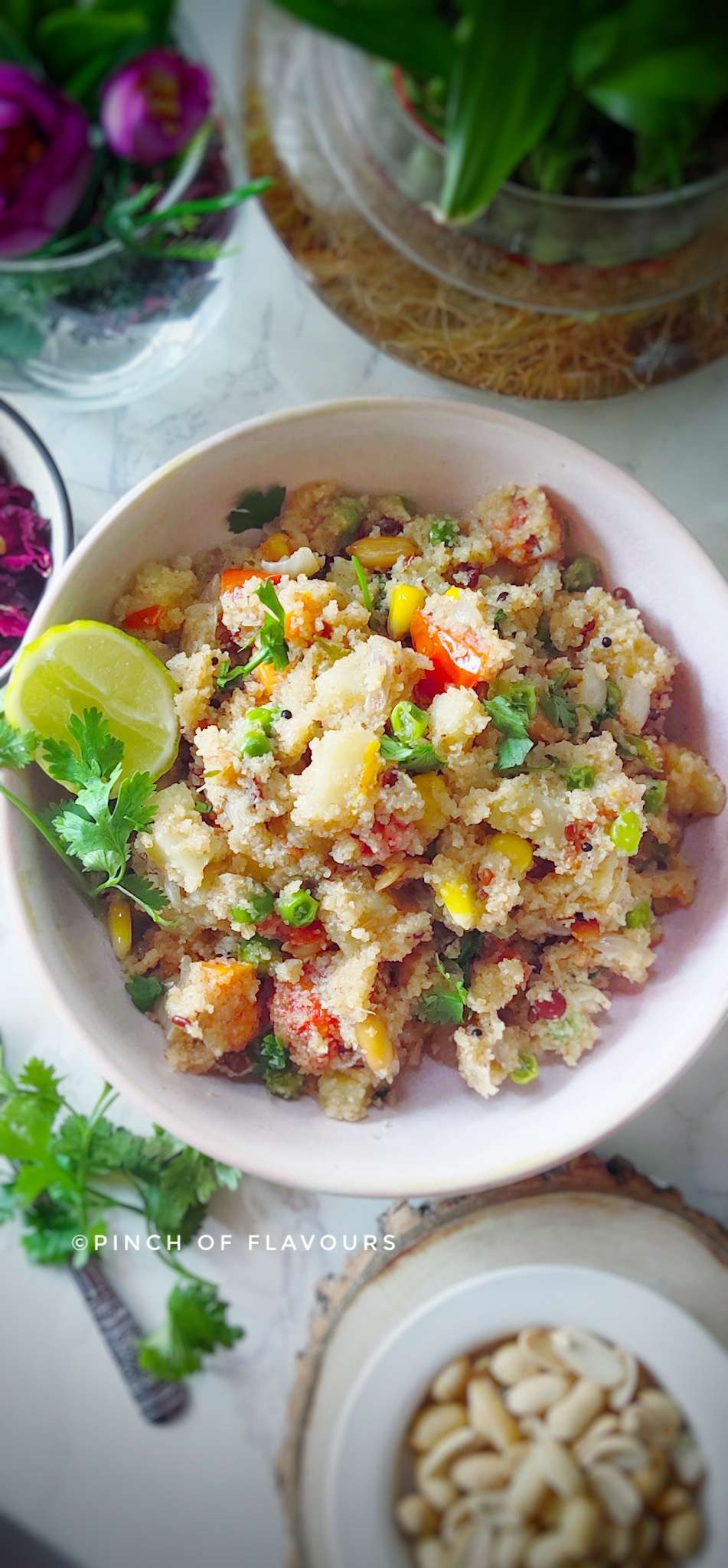
About Upma Recipe | Rava Upma Recipe
Rava (semolina or sooji), veggies, fresh ginger, curry leaves, and a few other simple ingredients are used to make a thick and fluffy savory porridge called upma. Easy to make and tasty, this South Indian breakfast recipe comes together in just 20 minutes.
The upma or cream of wheat breakfast dish is a favorite in South India. This version of the dish involves cooking rava in water flavored with ghee (or oil), cashews, lentils, peanuts, onion, and ginger among other ingredients. The dish will be mildly sweet and savory with the addition of sugar.
Uppumavu, Uppuma, or Uppindi are all traditional names for this sweet steamed semolina pudding. It is served as an everyday breakfast with coconut chutney, podi, and filter coffee.
It’s served not only at South Indian homes but also at restaurants, darshinies (roadside South Indian eateries), and tiffin centers as well.
There are many versions of upma available these days, including those made with bread, vermicelli, poha (flattened rice), oats, etc.
Porridge made with Indian semolina and vegetables is nutritious, wholesome, and filling. The vegetables can totally be omitted if you want to make it simpler. And you can make it vegan very easily if you want.
The best upmas are non-sticky and bursting with flavor. If you follow the recipe and measurements correctly, you can make fantastic sooji upma at home, but if you get the measurements wrong, it will turn into a mess.
No worries, my step-by-step recipe breaks down every step in detail for you. Simply follow the steps and you will make the best rava upma ever.No worries, my step-by-step recipe breaks down every step in detail for you. Simply follow the steps and you will make the best rava upma ever.
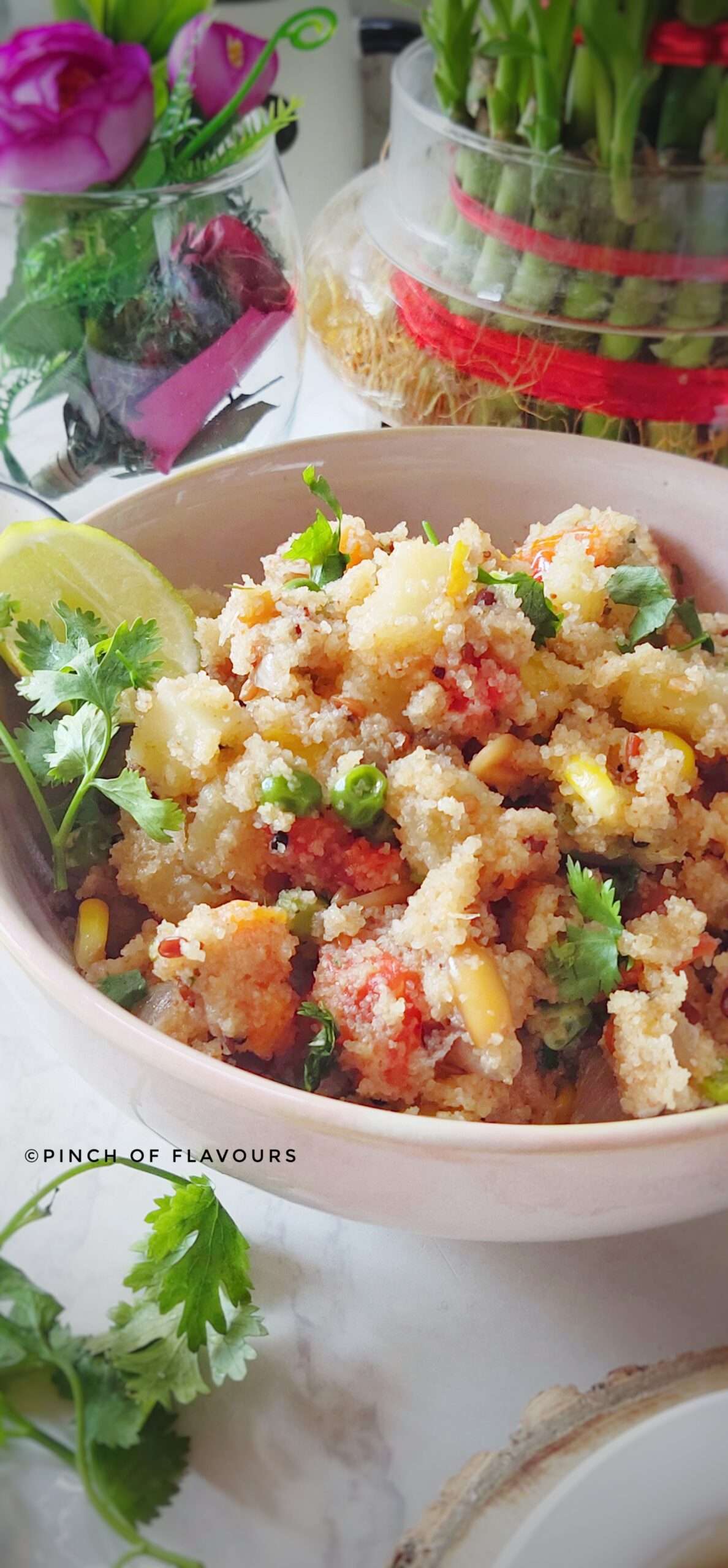
Ingredients
- 1 cup – Potato (diced)
- 1 cup – Onion (chopped)
- 1/2 cup – Carrots
- 1/2 cup – Fozen corns
- 1 cup – Frozen peas
- 1 – Tomato (chopped)
- 4 – Green chilly (chopped)
- 1 – Lemon juice/ Lemon slice
- 2 tbsp – Peanuts (roasted)
- 1 tbsp – Chana dal
- 1 tbsp – Urad dal
- 2 tbsp – Curry Leaves
- 1/2 inch – Ginger finely chopped
- 1 1/2 cup – Semolina /Suji
- 1 tbsp – Mustard seeds
- 1 tsp – Cumin seeds
- 1/2 tsp – Hing
- 1 tsp – Sugar (optional)
- Salt
- 2 tbsp – Ghee/Vegetable oil
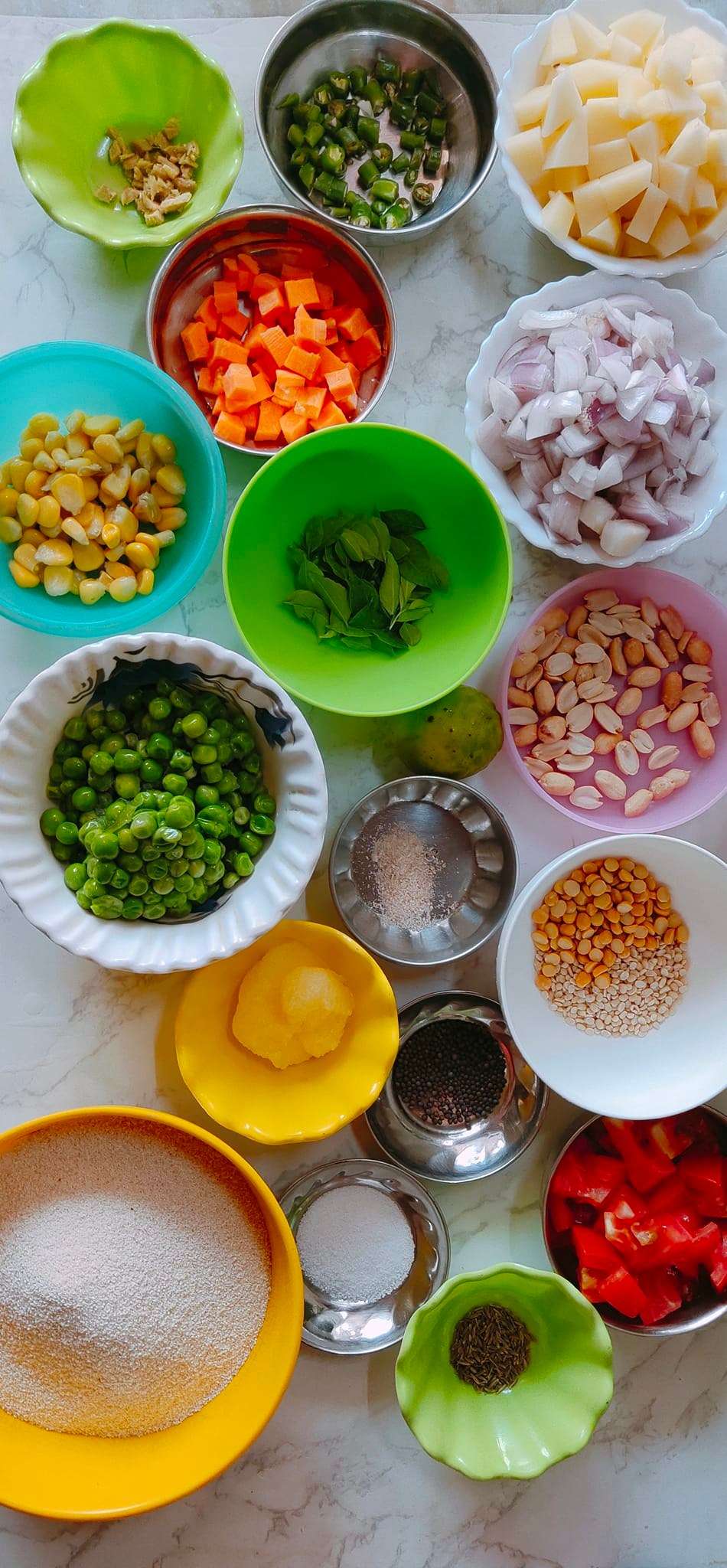
Rava – Rava may also be known as semolina or sooji. You can find it in numerous thicknesses, but rava upma is always made by using fine semolina or barik rava. Bombay rava or upma rava are also common names for the dish.
It is best to buy roasted rava because it has a longer shelf life and you don’t need to roast it as long.
Ghee/ Oil – The semolina will need to be roasted with ghee or vegetable oil. If you use clarified butter (ghee), your final dish will be delicious. Use any plant-based oil instead if you want to make a vegan version.
Tempering – Mustard seeds, curry leaves, nuts, and lentils are used to temper, which gives it a nice flavor and crunch.
If you make this upma, I highly recommend adding split and skinned black lentils (urad dal), Bengal gram (chana dal), and nuts like cashew nuts or peanuts to give it a nice crunch.
Additional Ingredients – I have also included onion, fresh ginger, and a few veggies like potatoes, carrots, green peas, frozen corns, and green chilies chopped, in my recipe. There is no need to include them if you wish to make a plain and simple upma.
There are many vegetables you can add to it, such as carrots, green beans, peas, mushrooms, cauliflower, zucchini, etc.
Hot Water – Rava upma’s texture is greatly influenced by the amount of water used. My upma is always perfectly fluffy and non-sticky because I use 2.5 cups of hot water per cup of semolina.
Lime and cilantro – To make it even more flavorful, add cilantro (coriander) at the end. Just before serving, drizzle some lime juice on top.
Check out the Upma Recipe | Rava Upma Recipe Video:
How To Make Upma Recipe | Rava Upma Recipe Step By Step With Photo:
- Add 1 & 1/2 cups fine semolina to a skillet and fry for 2-3 minutes until it turns very light brown and crunchy.
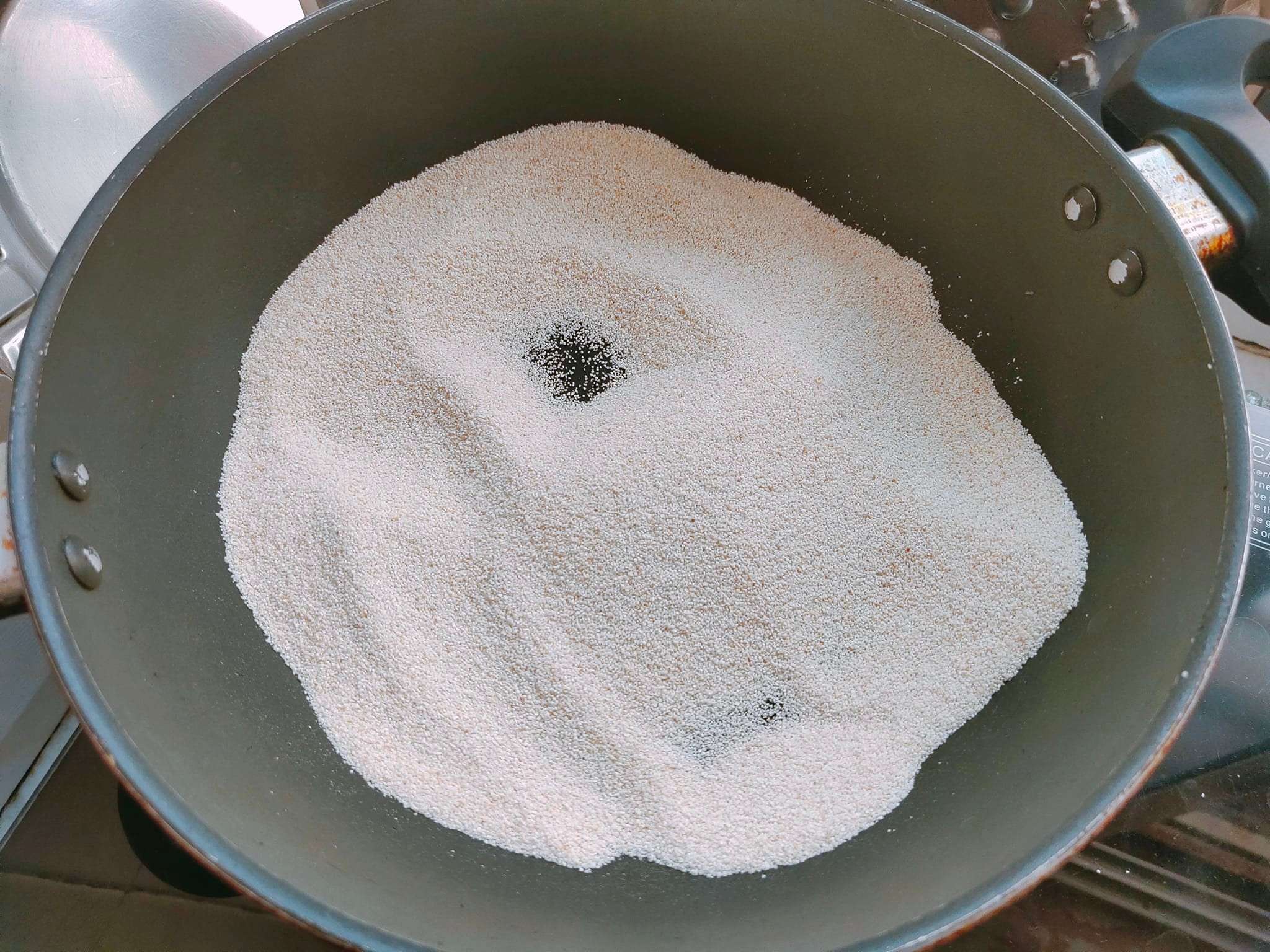
- Stir continuously while cooking. Once very light brown take out and keep the rava aside after it has been roasted.
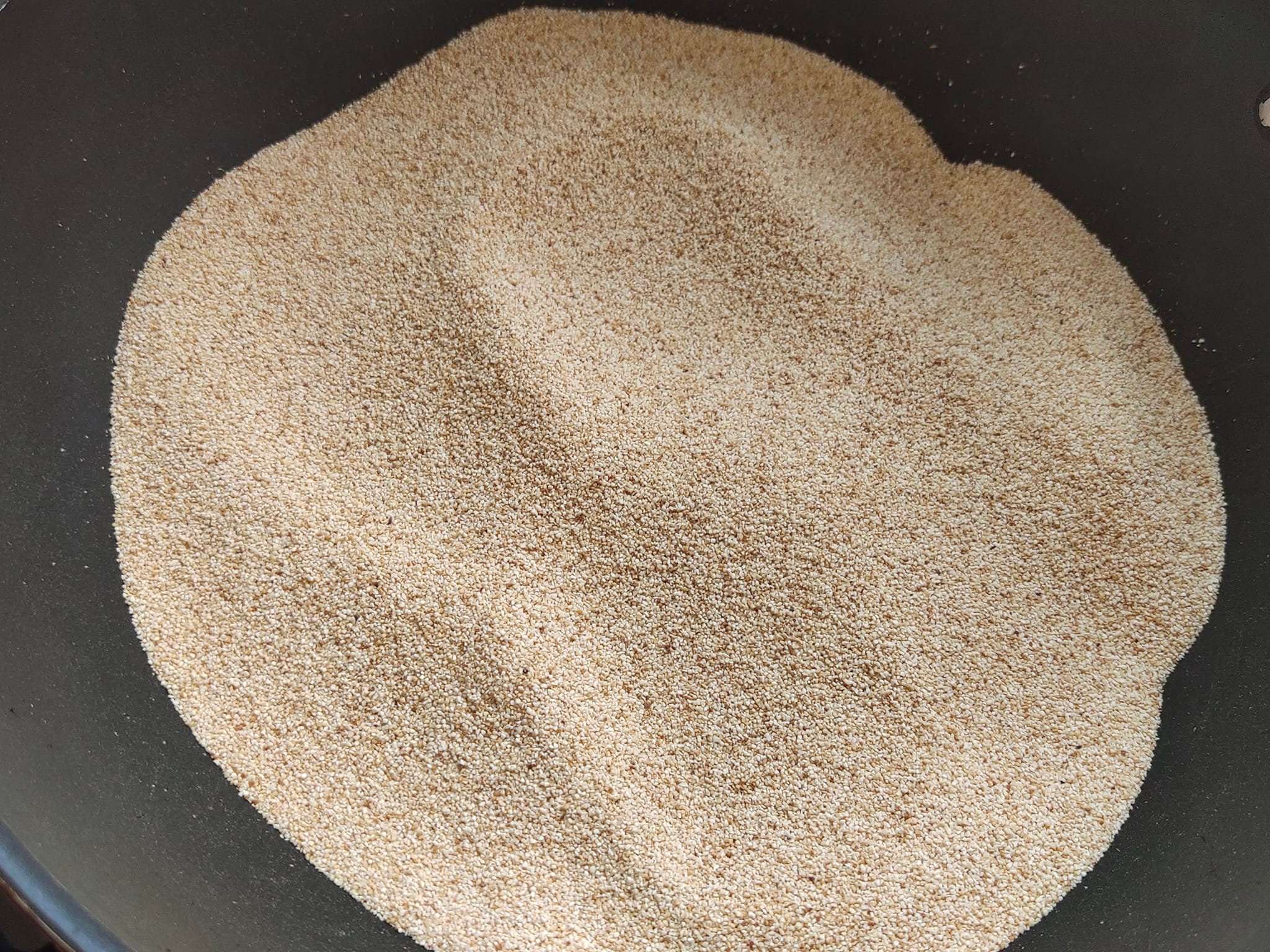
- Wipe the pan with a paper towel to remove any semolina that remains on it, and add 2 tablespoons of oil or ghee. If vegan use any vegetable oil. But the best flavors come when ghee is used. Place the pan over medium-high heat. Then add mustard seeds.
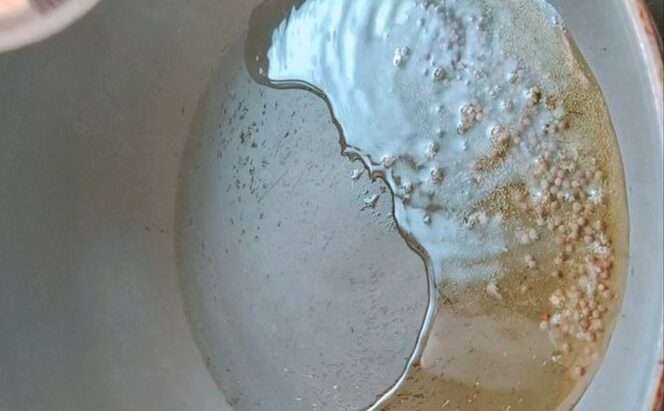
- Add cumin seeds, chana dal (husked and split Bengal gram) and urad dal (husked and split black gram) should now be added. Then add a little pinch of hing (Asafoetida).
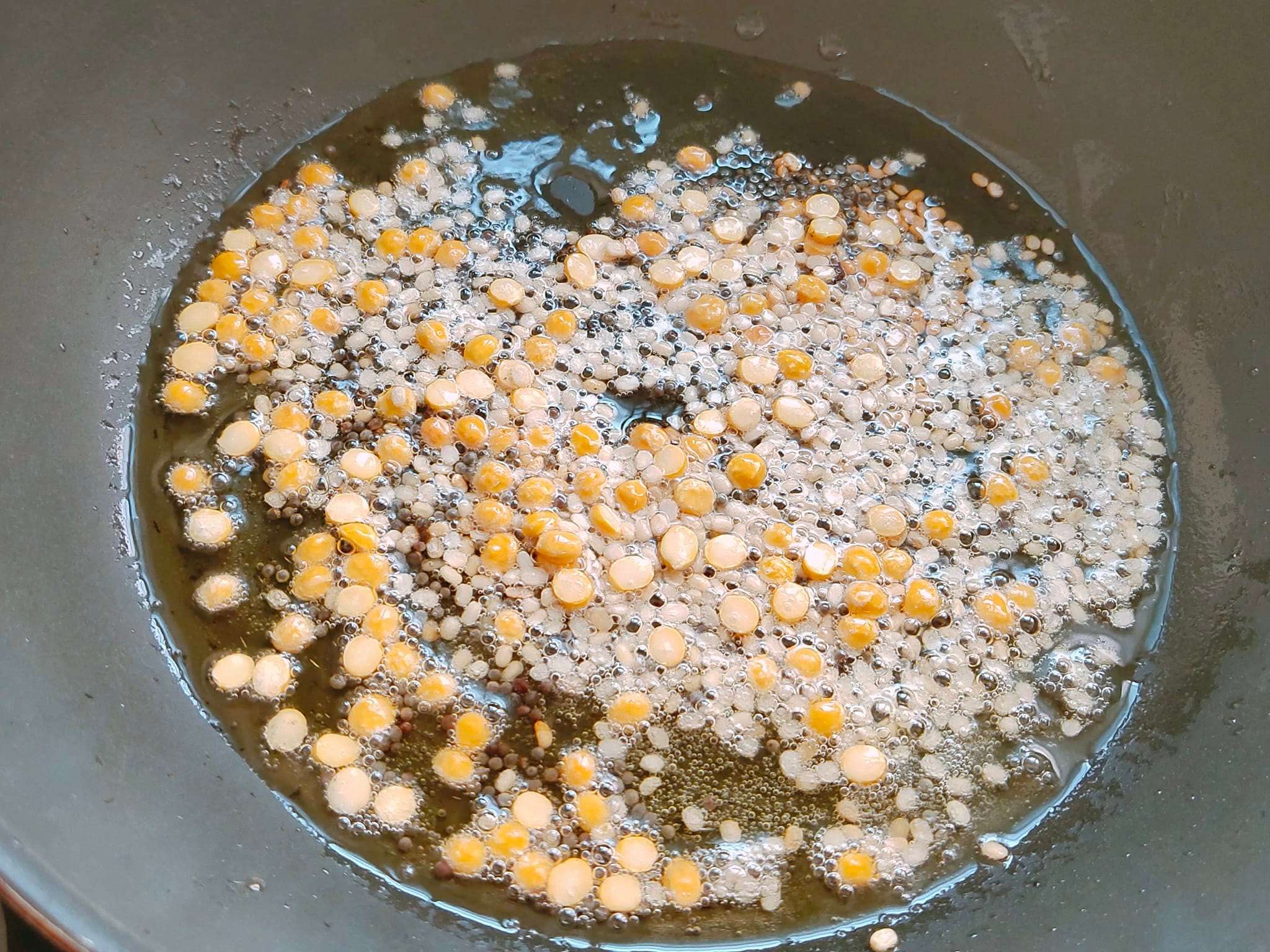
- Continue frying until the chana dal and urad dal are brown. Then add ginger chopped and fry till raw smell goes away.
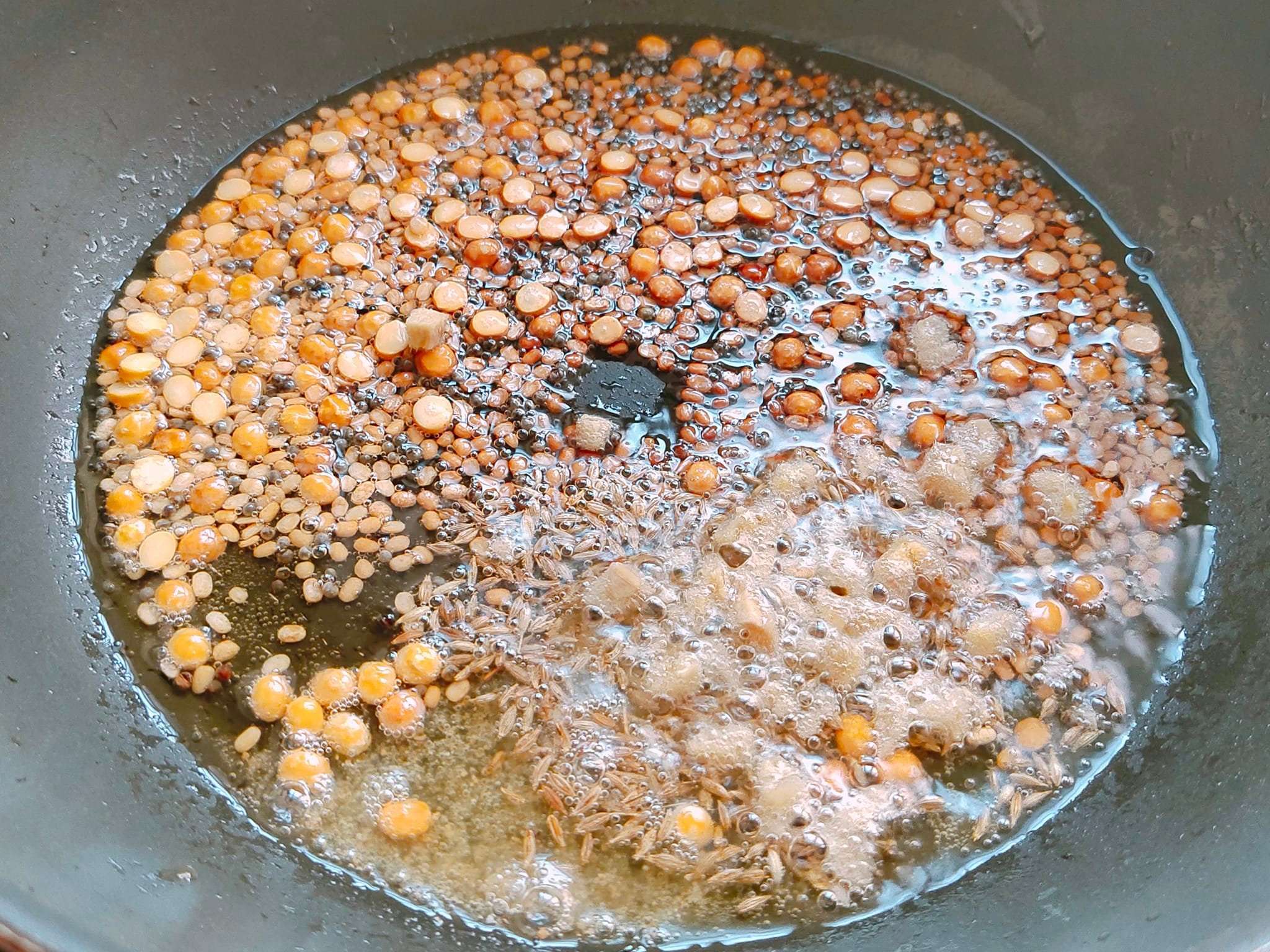
- Add 10 or 12 peanuts and curry leave and fry for 1 minute on medium-low heat.
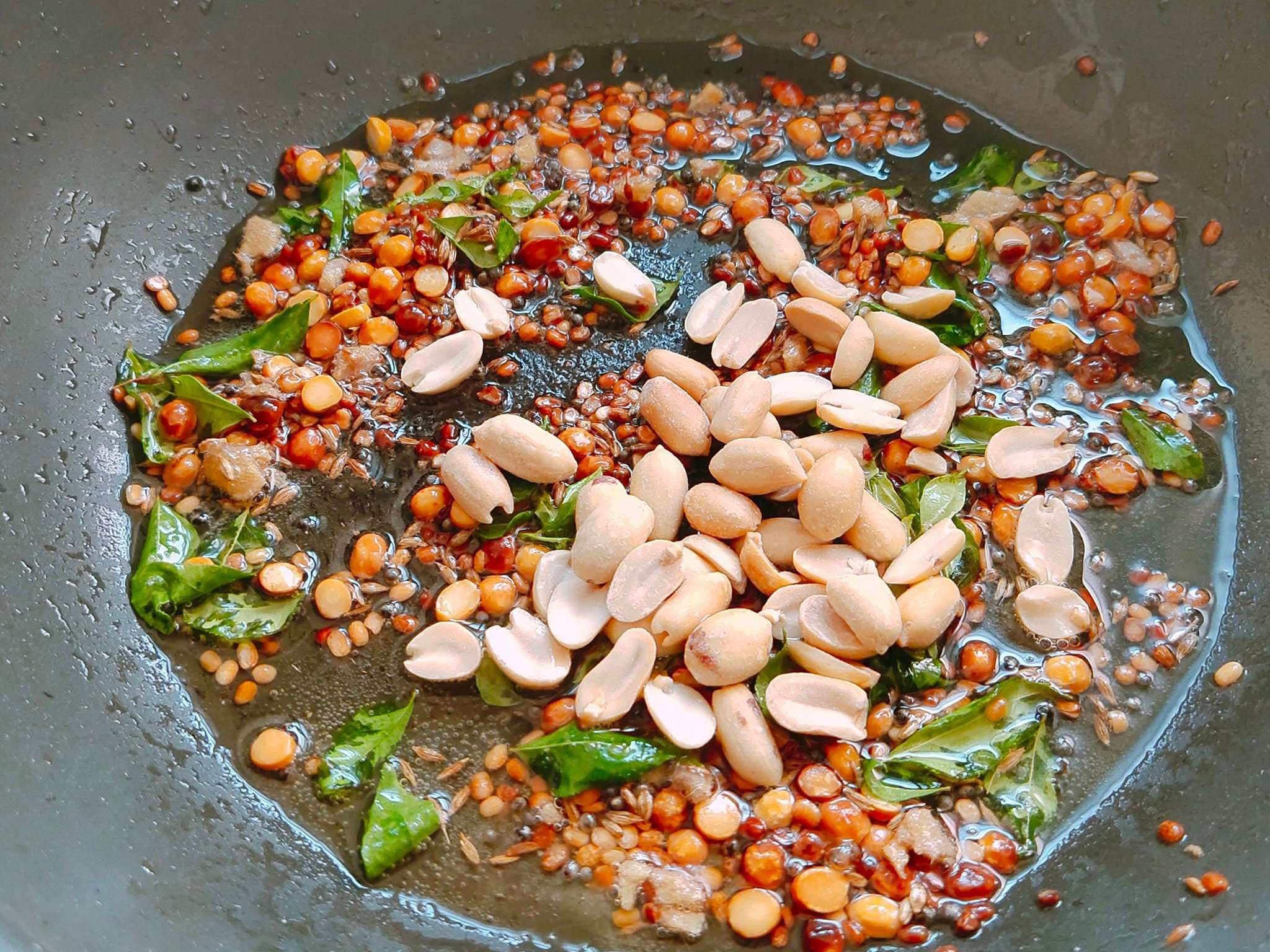
- Onions finely chopped should now be added.
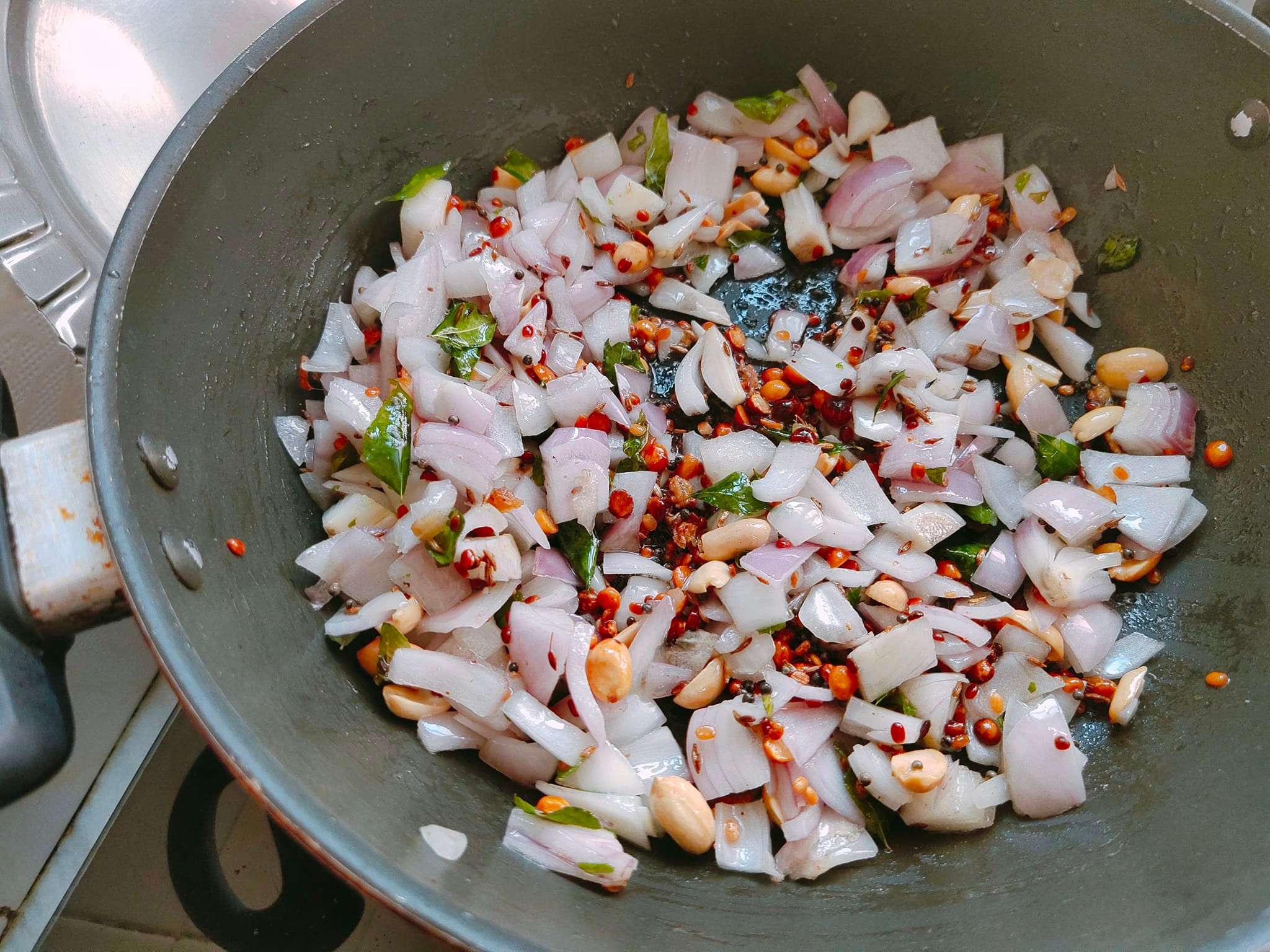
- On a low or medium-low heat, sauté the onions until they become translucent. Stir in the finely chopped green chilies and season with salt to taste.
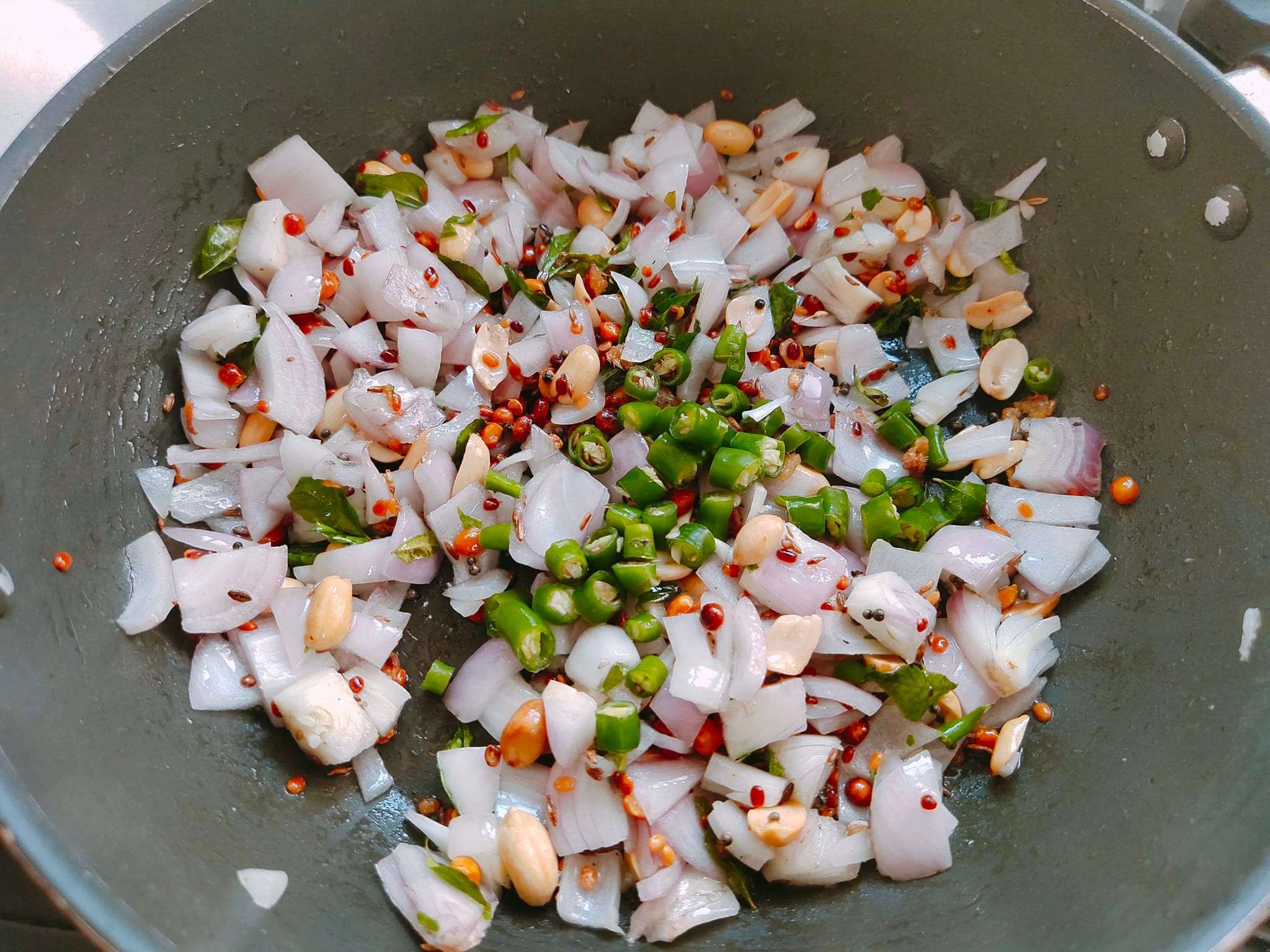
- Add 1/2 tsp sugar at this point but it’s optional and stir well.
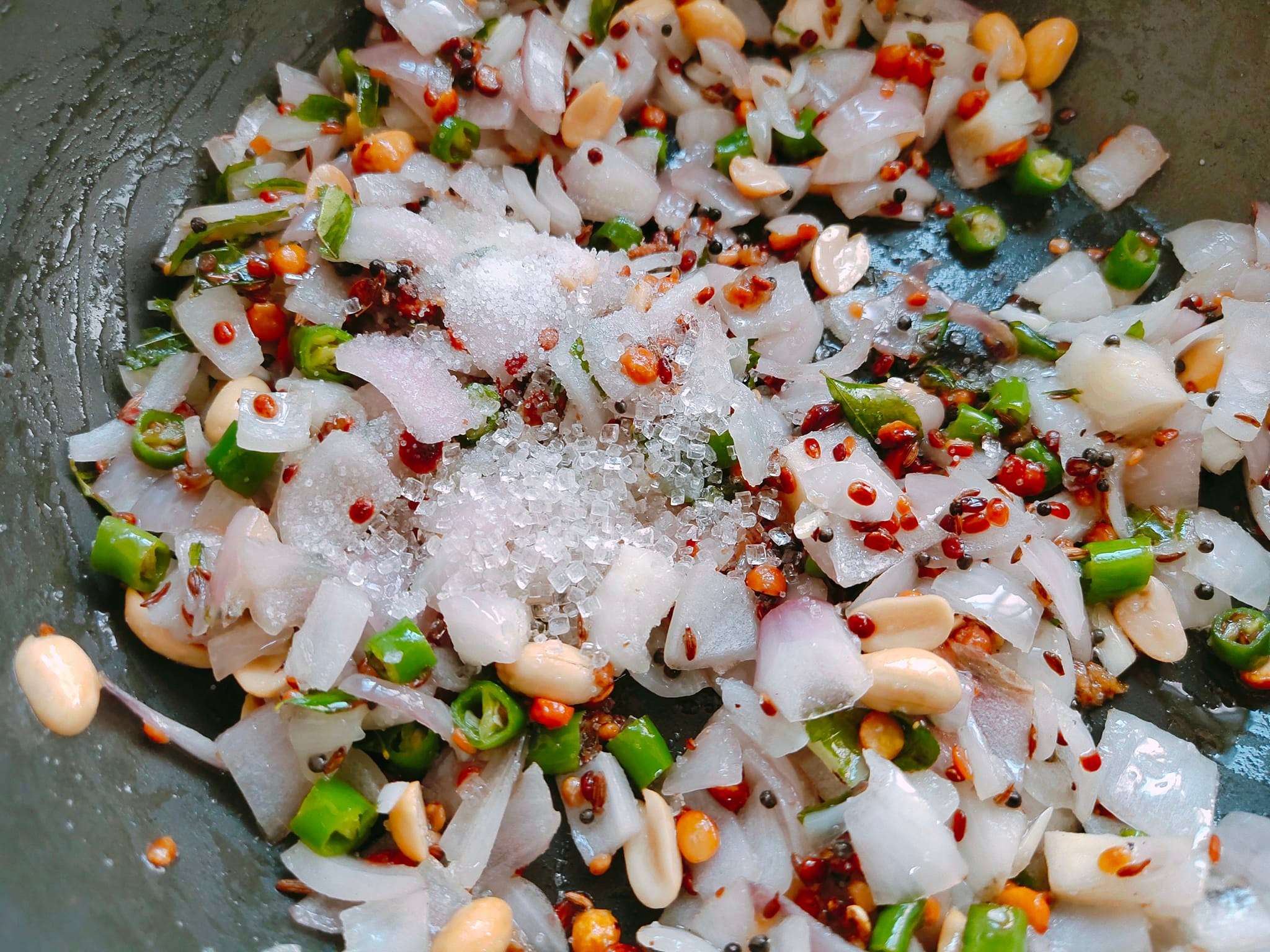
- Add salt to taste and mix well.
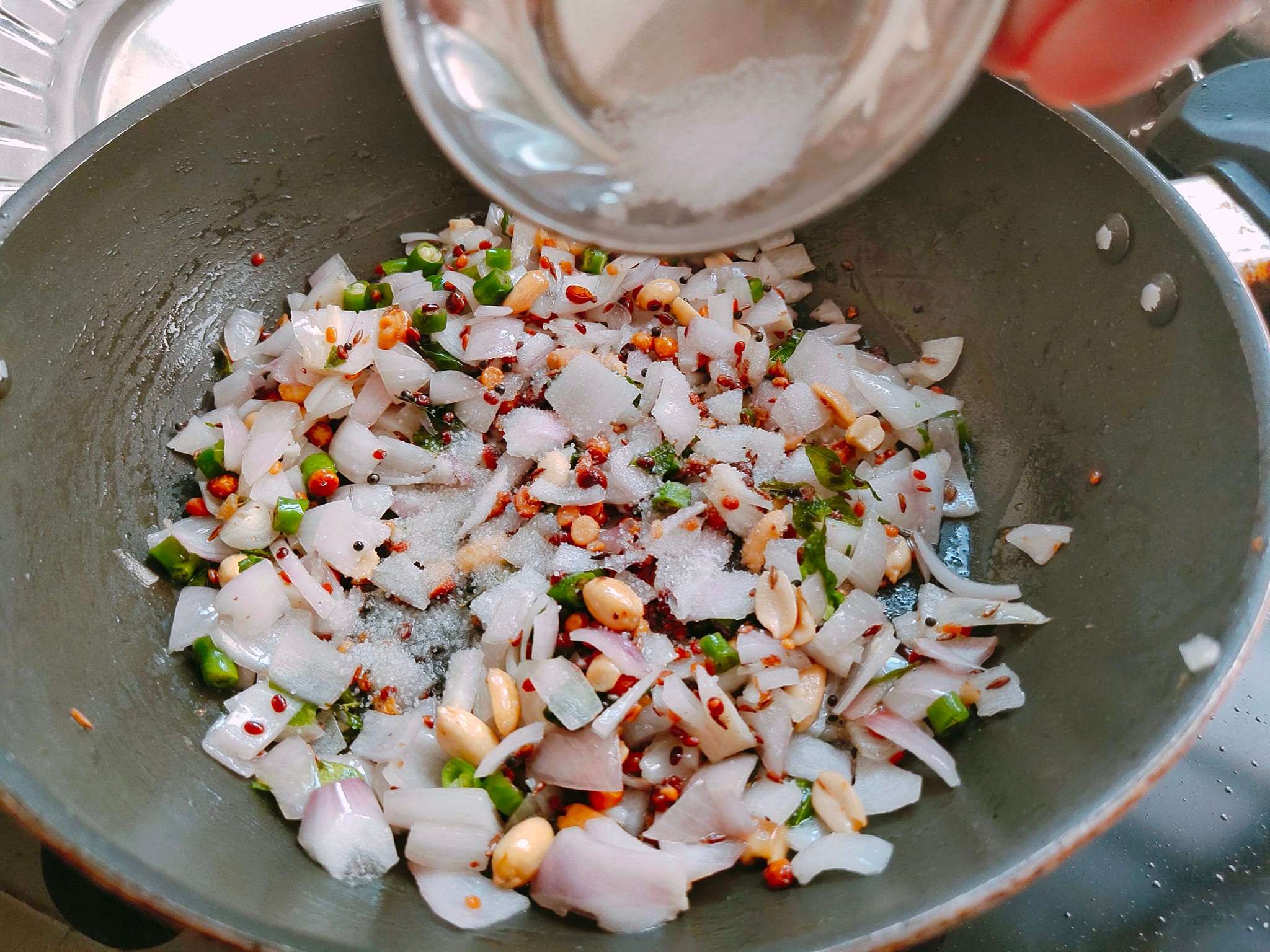
- Add potatoes, tomatoes and then stir well.
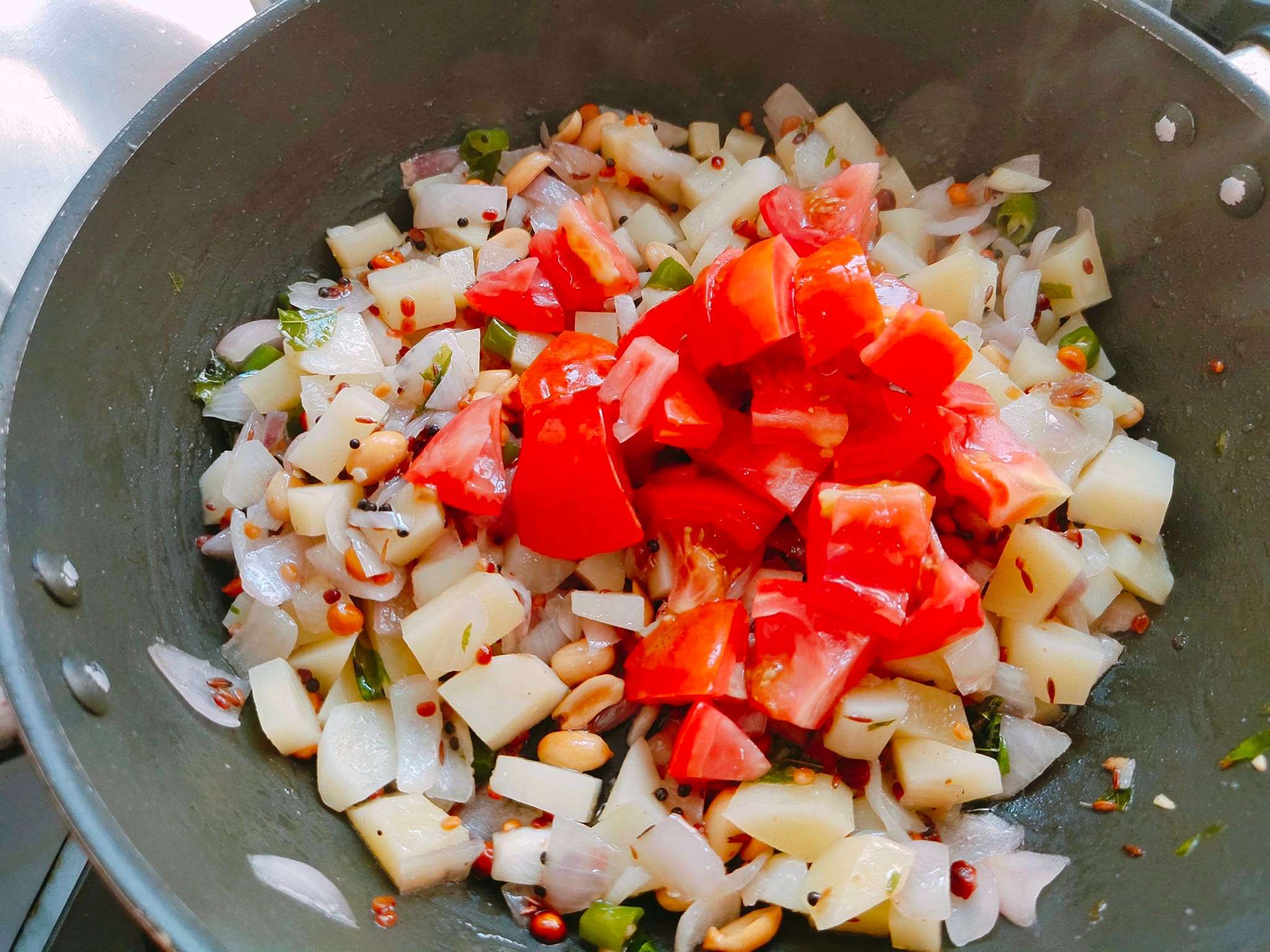
- Then add carrots, corn, green peas, then cook and cover for 3 minutes on medium flame.. Mix everything well.
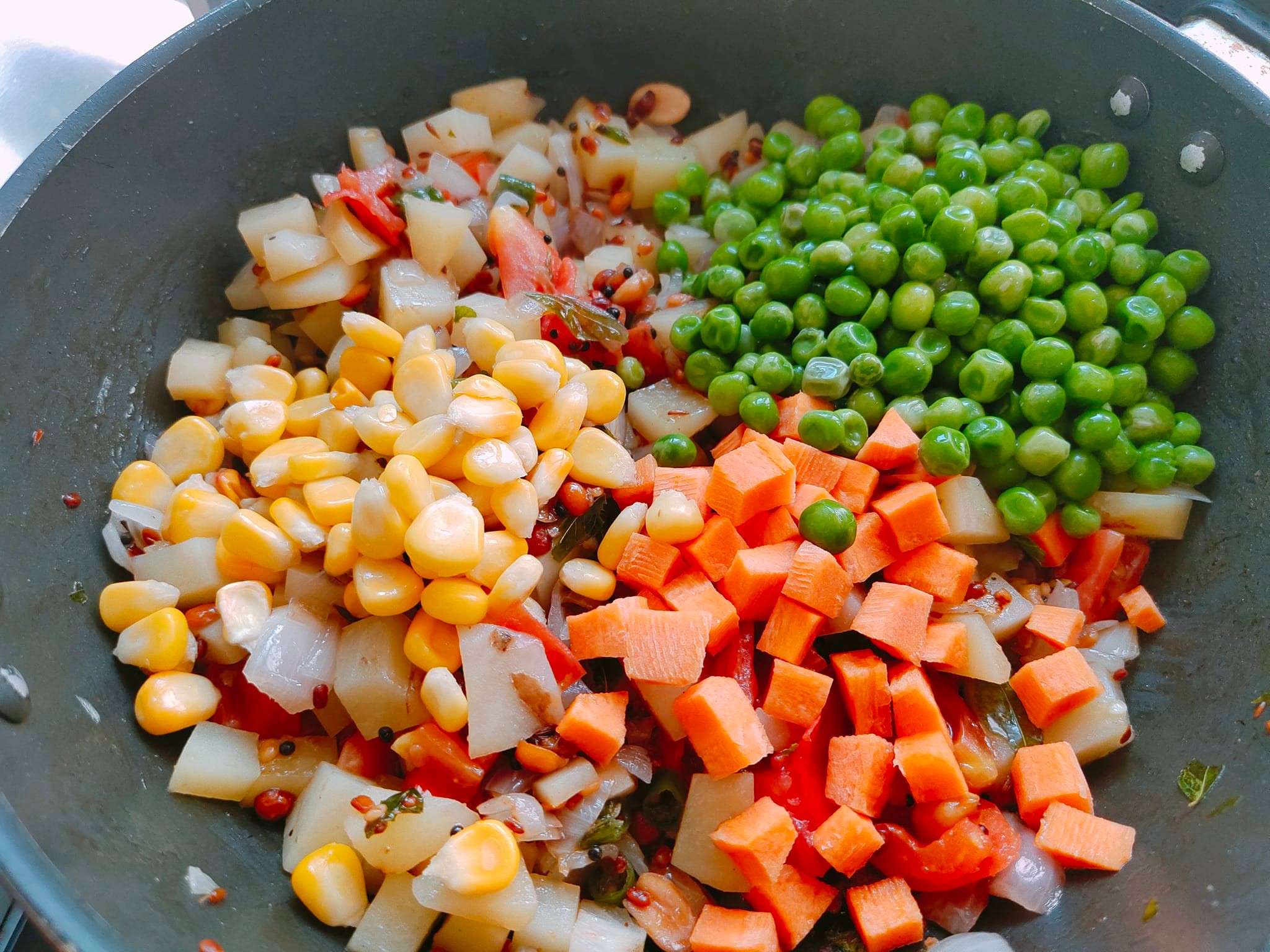
- Add 3.5 cups of water and let it boil for 5 minutes.
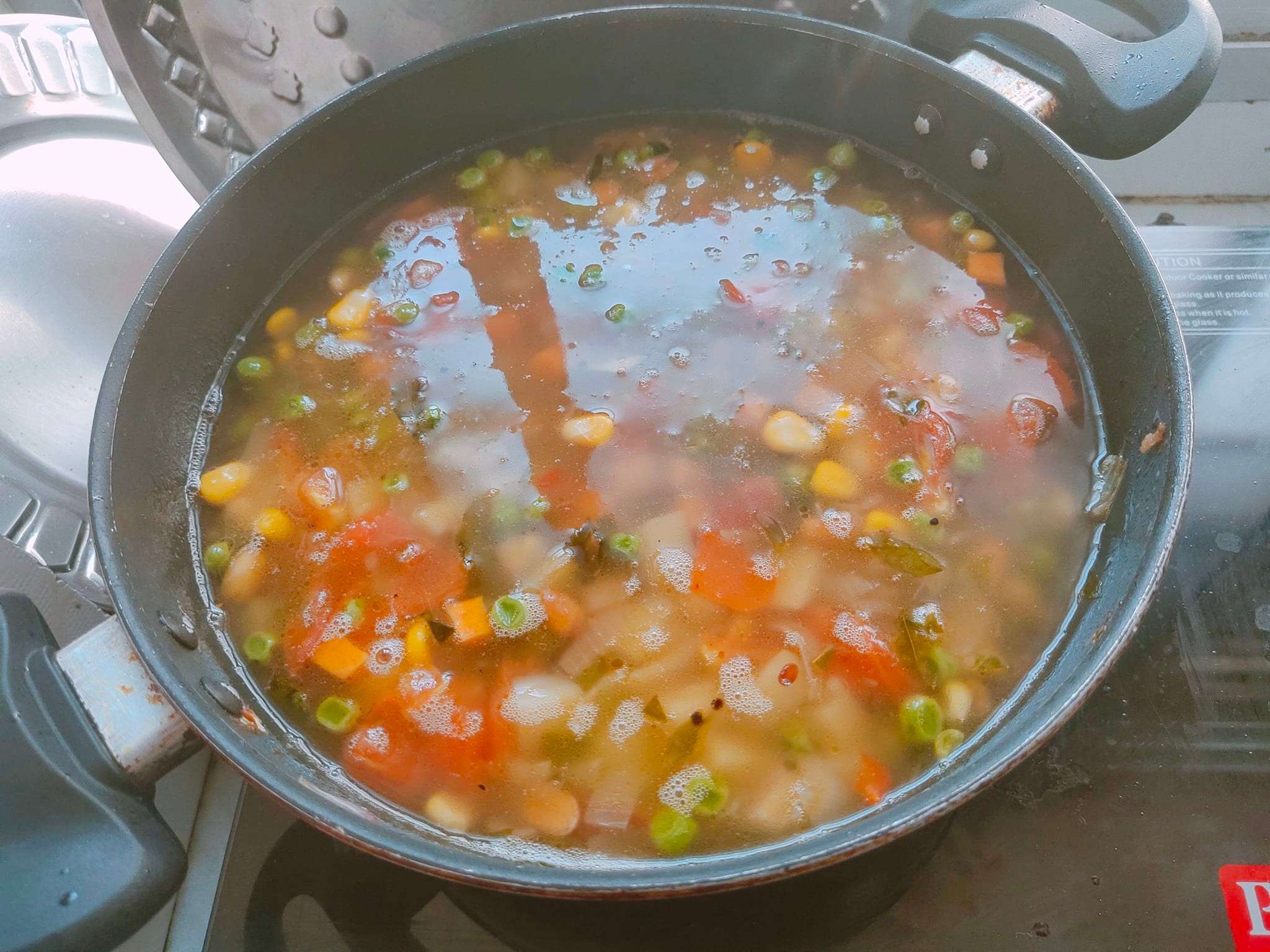
- Check the taste of the water after mixing well. The taste of the water should be slightly salty. When eating, you can always sprinkle salt from the top of the salt becomes low in the dish. Then add 3 to 4 tablespoons of roasted semolina or sooji in batches and mix well.
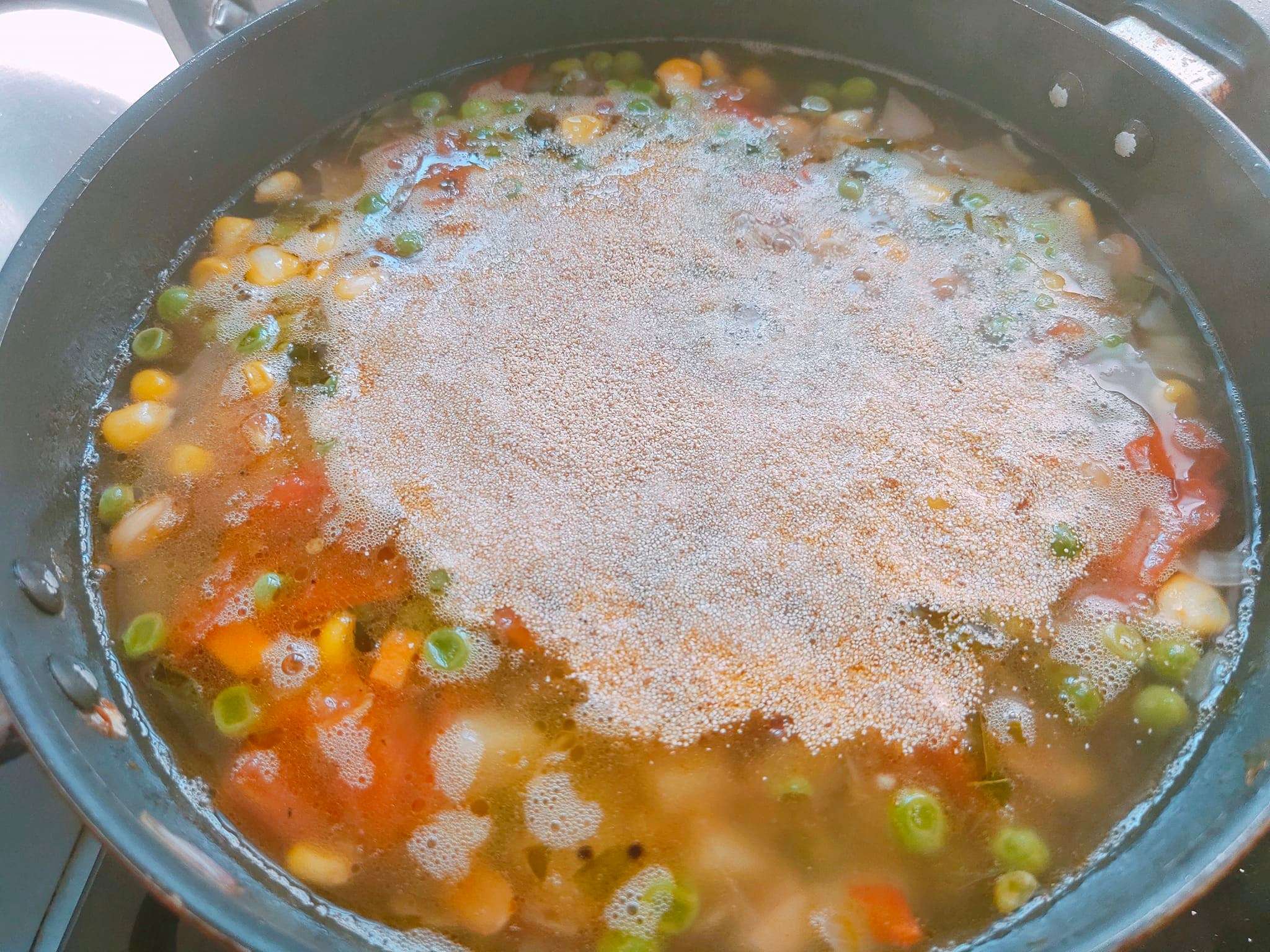
- Then keep adding the rest of the roasted semolina also in batches and mix well.
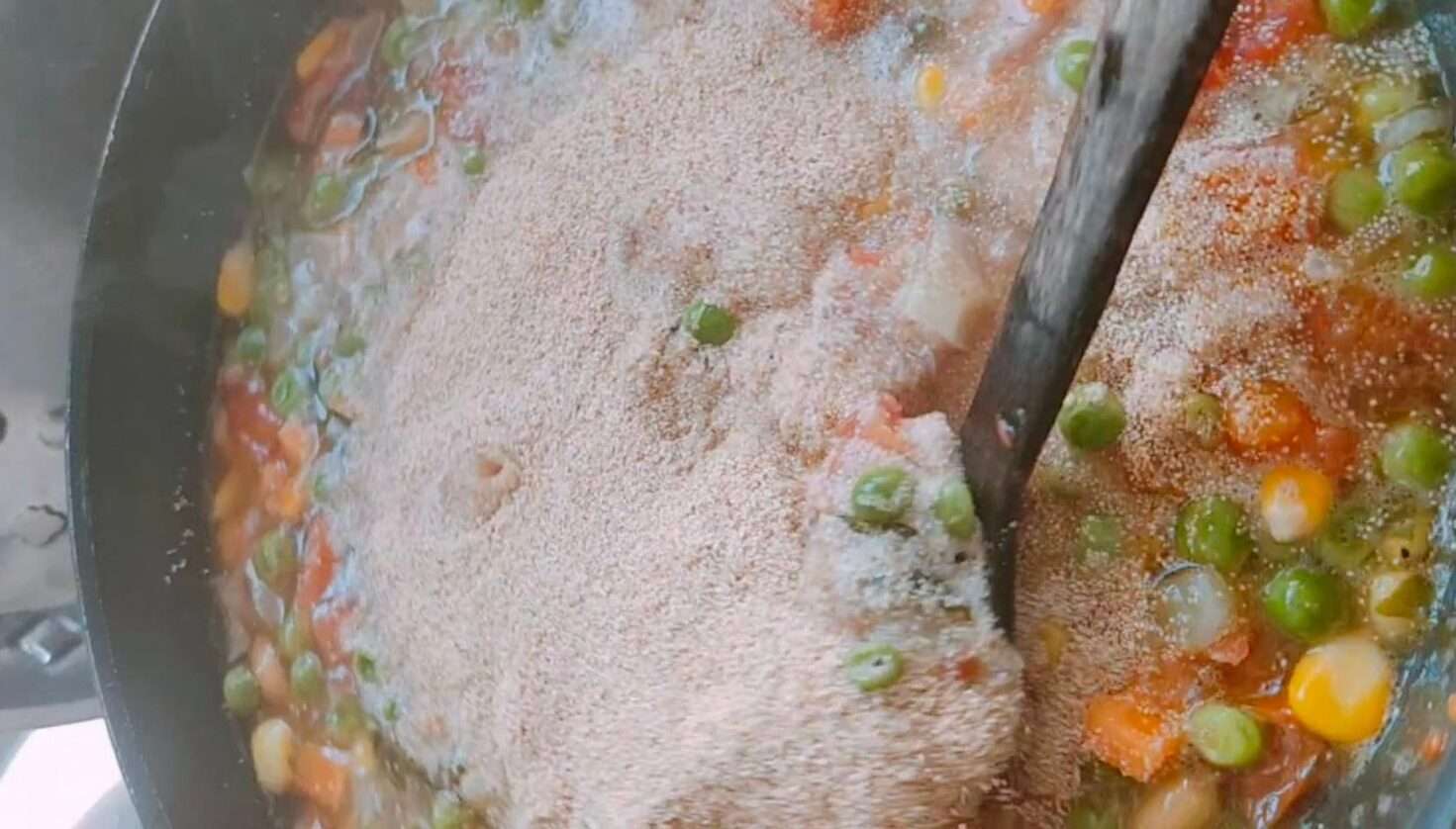
- Stir well and mix quickly. As the rava grains absorb water, they will swell and become cooked.
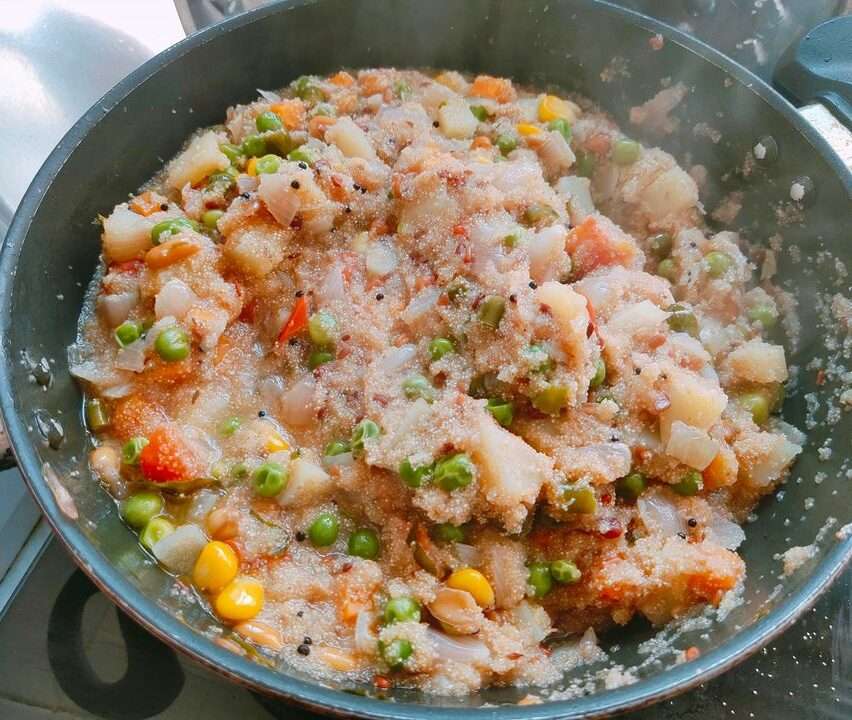
- Last but not least, add about 2 tablespoons of chopped coriander (cilantro). If you wish, you can add more.
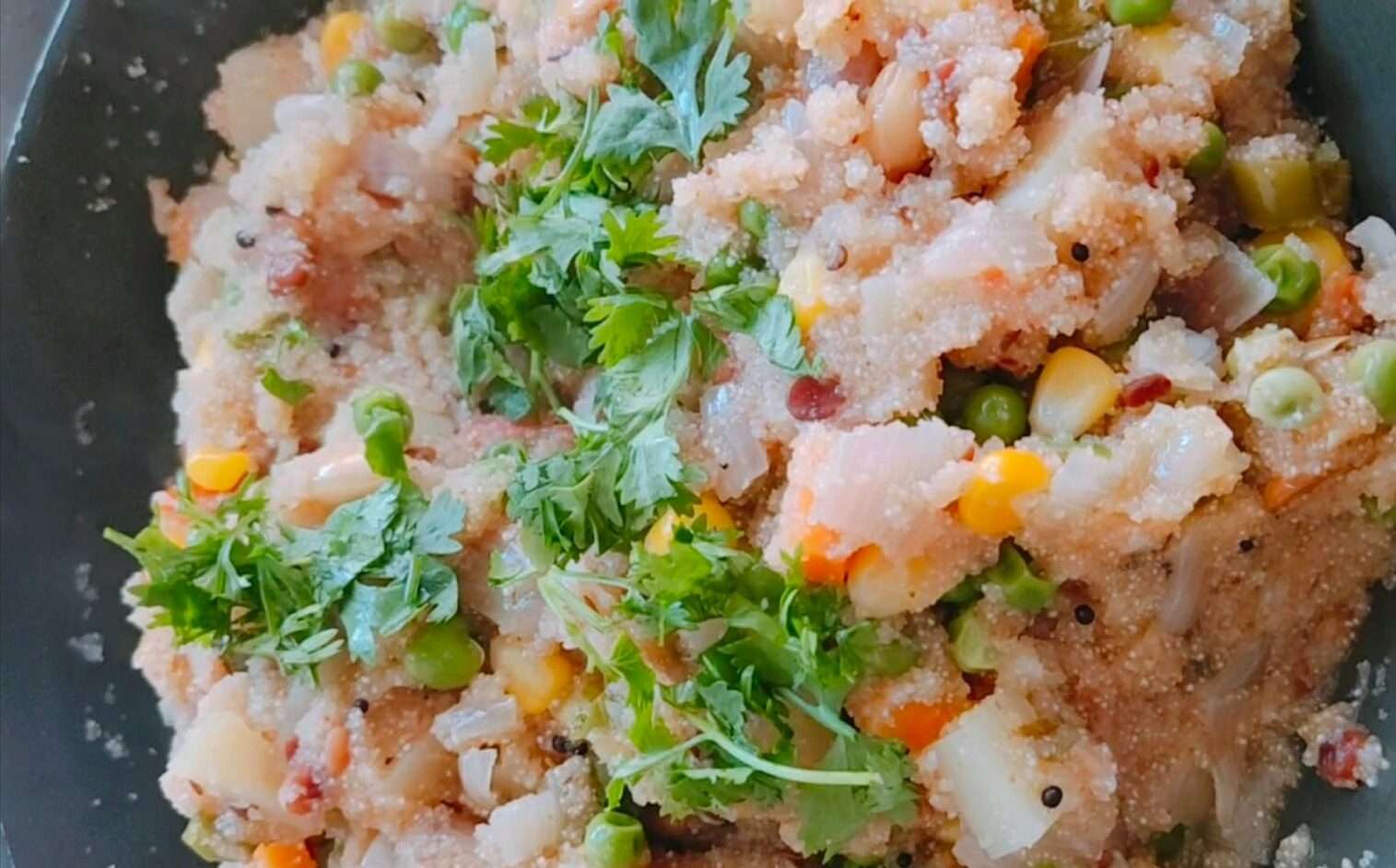
- Make sure the pan is covered with a lid. As the semolina soaks the water, covering the pan will make it softer.
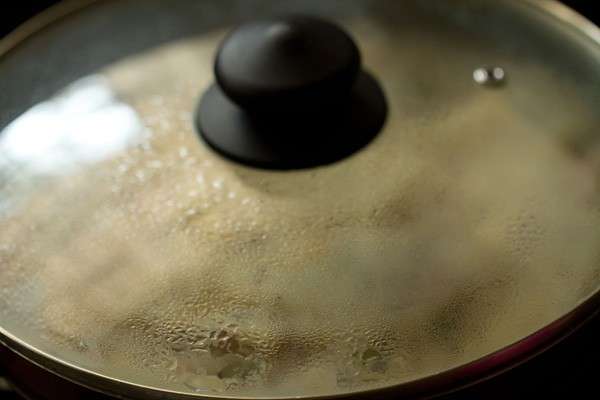
- Slices of lemon should be served with hot upma. The upma is also sprinkled with sev (fried gram flour vermicelli). Even though this isn’t how upma is traditionally served, the folks at home prefer this method. In addition to coconut chutney or lemon pickle, idli podi may be served. Rava Upma is ready to get served.
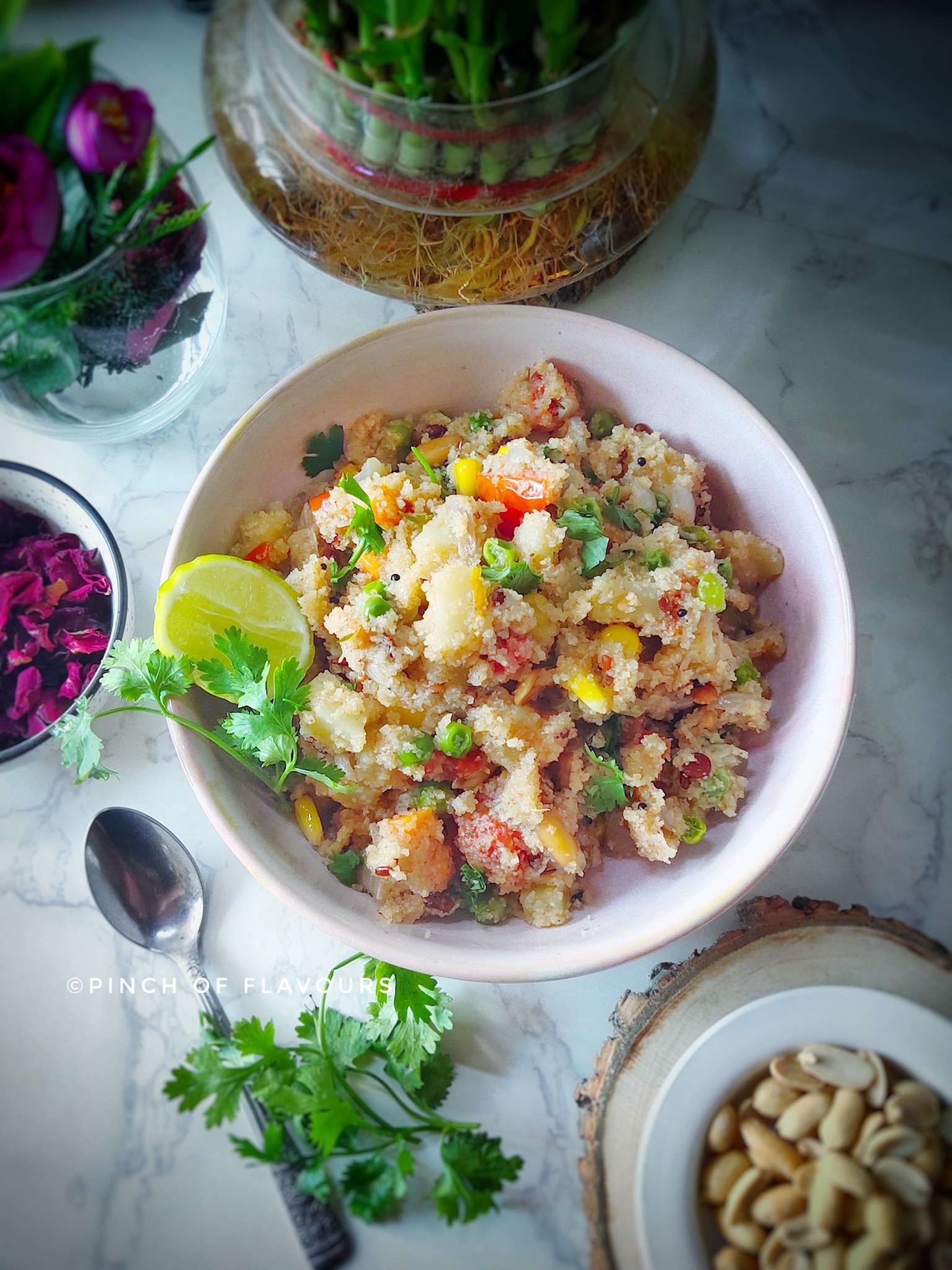
Upma Recipe | Rava Upma Important Suggestion To Keep In Mind
- Rava should be stirred frequently on a low or medium-low heat of the pan to achieve even roasting. A rava granule should look separate, crisp, and have a toasted aroma.
- Adding rava at a time: Always add rava to hot water in batches. Stir the rava evenly into the water after each addition. This will ensure that your upma turns out smooth and creamy.
- The proportion of rava to water can be 1:2.5 or 3 for softer Rava upma. In other words, you can add 2.5 to 3 cups of water per 1 cup of fine Rava.
- The vegetable upma or ragi Rava upma are just a few variations you can make. You can find these in the FAQ section below.
Serving suggestion
The best way to serve upma is hot or warm. Topping it off with some sev or bhujia and lemon juice is my favorite. In addition to coconut chutney and lemon pickle, you can serve upma with idli podi.
Storage Suggestion
This recipe can easily be halved or doubled. Upma leftover from the previous day can be refrigerated for a few days. It is even possible to freeze it. Sprinkle some water and reheat the upma in a pan while it is reheating.
Frequently Asked Questions
How do you define rava?
A rava is a finely ground or semi-finely ground wheat product. The texture is grainy but not floury. In English, rava is also called cream of wheat, farina, or semolina flour.
How healthy is rava upma?
Protein and carbohydrates are both available in it. In addition to being low in fat and calories, it is also ideal for weight loss diets.
It is also rich in vitamins B and iron. For a healthier version, you can add nuts and veggies.
Ragi rava upma: how to make it?
Separately roast the rava flour and the ragi flour. Prepare the recipe as directed. Immediately add the rava and ragi to the boiling water. The amount of water required will depend on the amount of ragi and rava added. Make sure you roast ragi well as undercooked ragi can cause stomach pains.
How come my upma has become lumpy?
When rava and water are not mixed well, upma becomes lumpy. Adding the rava in batches and mixing it evenly in the water is the best way to achieve a uniform rava. For this recipe, use fine rava. It will be necessary to add more water if you use a coarser rava.
How come my upma is sticky?
Rava has to be roasted well. The upma will become sticky if the rava isn’t properly roasted.
Where can I find the English names for urad dal and chana dal?
Bengal gram is the English name for Chana dal. Lentils made from black chickpeas. Black lentils or white lentils are called urad dal. Mung beans resemble them, however they are shaped like lentils and have a black husk and white lentils. It is also known as black matpe beans or Vigna mungo.
Vegan upma: How to make it?
You can replace ghee with any oil to make it vegan.
Some other recipes you would like on my blog – Russian Salad (OLIVIER SALAD), Spaghetti Aglio e Olio with Sun-Dried Tomatoes, Instant Pot Mint Rice (Pudina Pulao), Masala Macaroni Salad.
Print
Upma Recipe | Rava Upma
- Total Time: 30 minutes
- Diet: Vegan
Description
One of the most popular breakfast recipes in South India, Upma Recipe | Rava Upma is now popular throughout the country. Using ingredients commonly found in the Indian kitchen, rava upma can quickly be prepared without a lot of hassle.
Ingredients
- 1 cup – Potato (diced)
- 1 cup – Onion (chopped)
- 1/2 cup – Carrots
- 1/2 cup – Fozen corns
- 1 cup – Frozen peas
- 1 – Tomato (chopped)
- 4 – Green chilly (chopped)
- 1 – Lemon juice/ Lemon slice
- 2 tbsp – Peanuts (roasted)
- 1 tbsp – Chana dal
- 1 tbsp – Urad dal
- 2 tbsp – Curry Leaves
- 1/2 inch – Ginger finely chopped
- 1 1/2 cup – Semolina /Sooji
- 1 tbsp – Mustard seeds
- 1 tsp – Cumin seeds
- 1/2 tsp – Hing/Aspfoetida
- 1 tsp – Sugar (optional)
- Salt to taste
- 2 tbsp – Ghee/Vegetable oil
Instructions
- Add 1 & 1/2 cups fine semolina to a skillet and fry for 2-3 minutes until it turns very light brown and crunchy.
- Stir continuously while cooking. Once very light brown take out and keep the rava aside after it has been roasted.
- Wipe the pan with a paper towel to remove any semolina that remains on it, and add 2 tablespoons of oil or ghee. If vegan use any vegetable oil. But the best flavors come when ghee is used. Place the pan over medium-high heat. Then add mustard seeds.
- Add cumin seeds, chana dal (husked and split Bengal gram) and urad dal (husked and split black gram) should now be added. Then add a little pinch of hing (Asafoetida).
- Fry often until the chana dal and urad dal begin to brown. Then add ginger chopped and fry till raw smell goes away.
- Add 10 or 12 peanuts and curry leave and fry for 1 minute on medium-low heat.
- Onions finely chopped should now be added.
- On a low or medium-low heat, sauté the onions until they become translucent. Stir in the finely chopped green chilies and season with salt to taste.
- Add 1/2 tsp sugar at this point but it’s optional and stir well.
- Add salt to taste and mix well.
- Add potatoes, tomatoes and then stir well.
- Then add carrots, corn, green peas, then cook and cover for 3 minutes on medium flame.. Mix everything well.
- Add 3.5 cups of water and let it boil for 5 minutes.
- Check the taste of the water after mixing well. The taste of the water should be slightly salty. When eating, you can always sprinkle salt from the top if the salt becomes low in the dish. Then add 3 to 4 tablespoons of roasted semolina or sooji in batches and mix well.
- Then keep adding the rest of the roasted semolina also in batches and mix well.
- Stir well and mix quickly. As the rava grains absorb water, they will swell and become cooked.
- Last but not least, add about 2 tablespoons of chopped coriander (cilantro). If you wish, you can add more.
- Make sure the pan is covered with a lid. As the semolina soaks the water, covering the pan will make it softer.
- Slices of lemon should be served with hot upma. The upma is also sprinkled with sev (fried gram flour vermicelli). Even though this isn’t how upma is traditionally served, the folks at home prefer this method. In addition to coconut chutney or lemon pickle, idli podi may be served. Rava Upma is ready to get served.
Recommended Products
As an Amazon Associate and member of other affiliate programs, I earn from qualifying purchases.
[equipments]Notes
- Rava should be stirred frequently on a low or medium-low heat of the pan to achieve even roasting. A rava granule should look separate, crisp, and have a toasted aroma.
- Adding rava at a time: Always add rava to hot water in batches. Stir the rava evenly into the water after each addition. This will ensure that your upma turns out smooth and creamy.
- The proportion of rava to water can be 1:2.5 or 3 for softer Rava upma. In other words, you can add 2.5 to 3 cups of water per 1 cup of fine Rava.
- The vegetable upma or ragi Rava upma are just a few variations you can make. You can find these in the FAQ section below.
- Prep Time: 15 minutes
- Cook Time: 15 minutes
- Category: Breakfast
- Method: Stove-Top
- Cuisine: Indian, South Indian
Nutrition
- Serving Size: 4 people
- Calories: 156Kcal
- Sugar: 4g
- Sodium: 24mg
- Fat: 11g
- Saturated Fat: 6g
- Trans Fat: 0g
- Carbohydrates: 9g
- Fiber: 2g
- Protein: 2g
- Cholesterol: 29mg
Keywords: rava upma recipe, rava upma, rava upma recipe, rava upma water ratio
Note: A rough estimate of nutrition is provided.

We Love to hear back from you and appreciate your success stories!
Have you tried this “Recipe”? Please feed us with your ★ star ratings and comments below.
You can also FOLLOW me on FACEBOOK, INSTAGRAM, and PINTEREST for more fabulous recipes and updates.
*SOME OF THE LINKS IN THIS POST ARE AFFILIATE LINKS AND WE WILL RECEIVE A COMMISSION IF YOU MAKE A PURCHASE AFTER CLICKING ON OUR LINK. THANK YOU FOR SUPPORTING OUR WORK HERE AT Pinchofflavours!






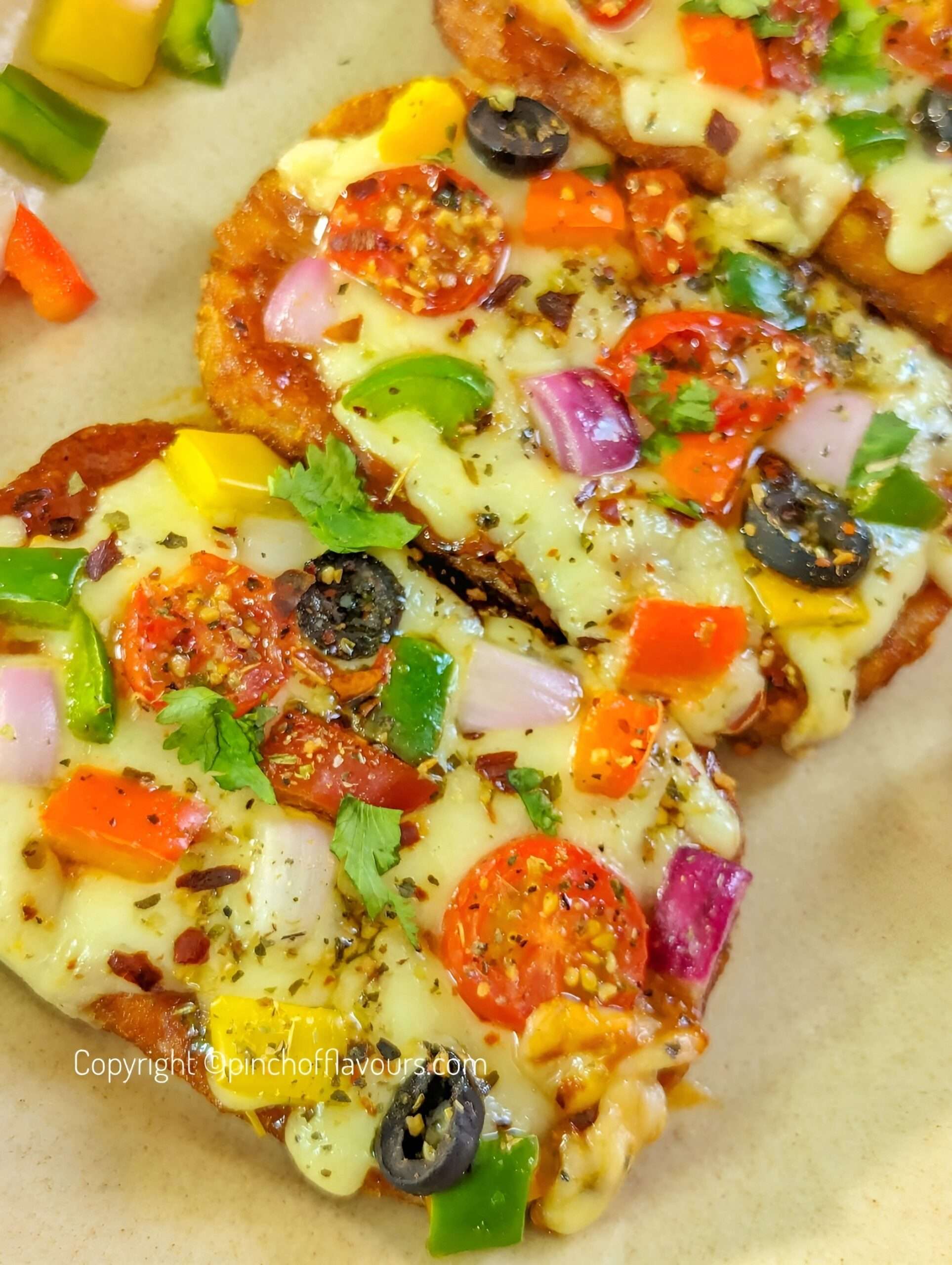
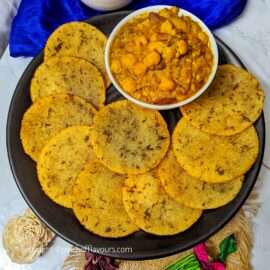
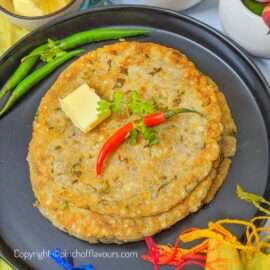


Leave a Reply